Learn about different philosophies used in the determination of soil bearing capacity.
One of the first steps required in any structural design is determining the safe bearing capacity of the soil, qa, at the site. Terzaghi (1943) was the first to present a comprehensive theory for evaluating the ultimate soil-bearing capacity of shallow foundations. Terzaghi suggested that for a continuous or strip foundation (i.e., one whose width-to-length ratio approaches zero), the failure surface in the soil at ultimate load may be assumed as a logarithmic spiral surface (see Figure 1). (Note that this is the case of general shear failure.)
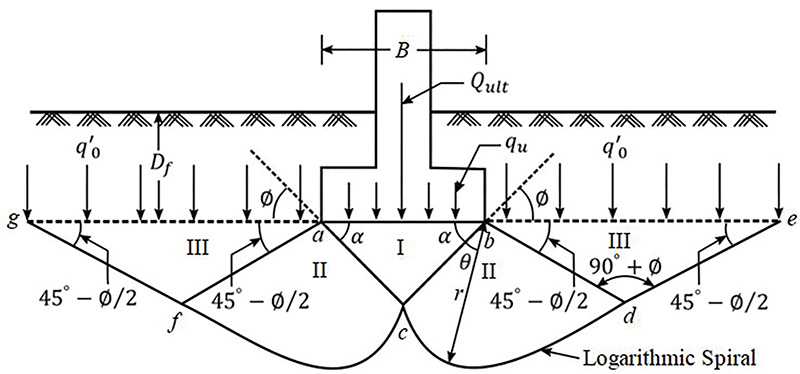
The ultimate soil-bearing capacity equations contain three factors: Nc, Nq, and Nγas shown in Eqn.1. Although there is not much dispute in the calculation of Nc and Nq, there is disagreement regarding using the proper value of Nγ. The differences in the reported Nγ values are substantial compared with those proposed initially by Terzaghi. Hence, one must be careful while selecting the Nγ value in their calculations.

Using an equilibrium analysis, Terzaghi expressed the ultimate bearing capacity of continuous or strip foundation as:

Where A = area of footing in ft2, B = width of footing in ft, c = cohesion in psf, Df= depth of surcharge in ft (See Figure 2), Q = ultimate bearing capacity, lb, qu= ultimate bearing capacity in psf, γ0, γ1 = unit weight of soil in lbs/ft3, Nc, Nq, Nγ = bearing capacity factors that are non-dimensional and are functions only of the soil friction angle ϕ. This equation (1) is known as Buisman-Terzaghi equation.
The net ultimate bearing capacity and safe bearing capacities will be as follows: (Deducting γ0Df from qu to get qnet)
qnet = cNc + γ0Df (Nq − 1) + 0.5γ1BNγ (2)
qsafe = qnet /FS + γ0Df (3)
It must be noted that no safety factor is applied to the surcharge.Terzaghi’s bearing capacity equations have now been modified to consider the effects of the foundation shape, depth of embedment, and load inclination. The details of these equations may be found in any standard textbooks on Soil Mechanics [e.g., Bowles (1996), Coduto (2015)]. It must be noted that many design engineers still use the Terzaghi equation, which is considered to provide fairly good results.
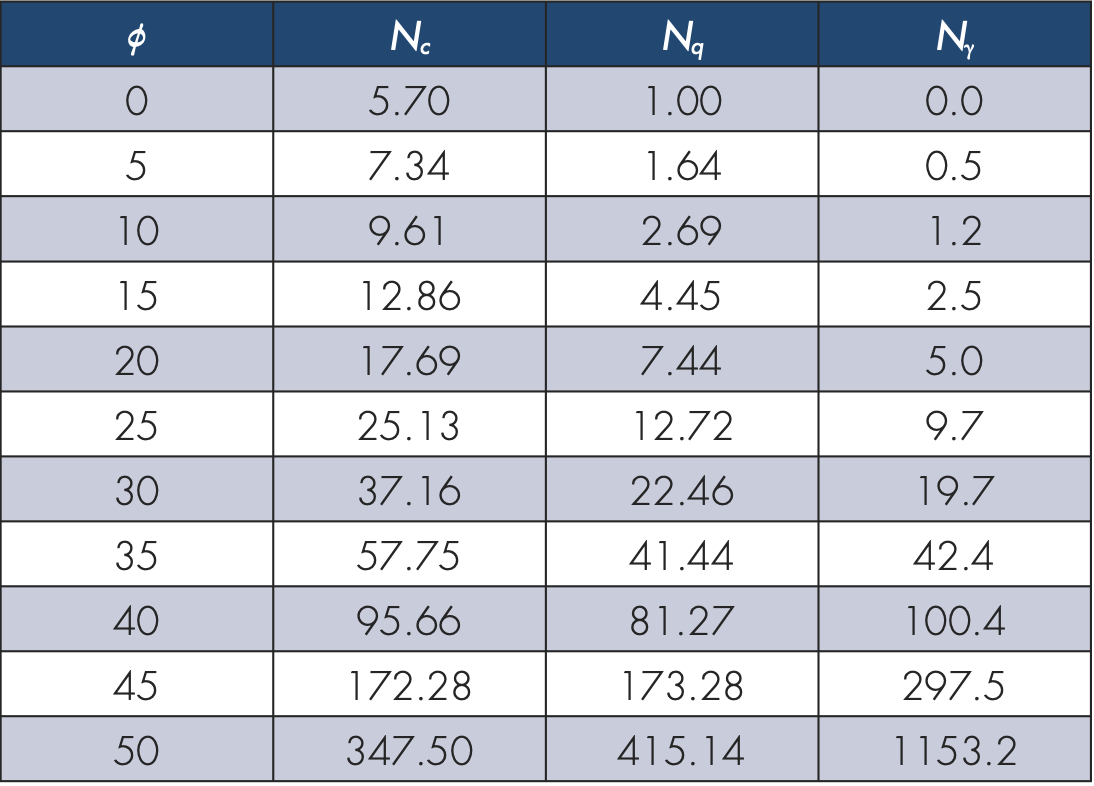
Bearing Capacity Factors
Although there is no dispute in the calculation of Nc and Nq, there is more disagreement regarding the proper value of Nγ . Some of the proposed equations for these factors by different researchers are discussed below.
Equations Suggested by Terzaghi (1943)
The bearing capacity factors were defined by Terzaghi (1943) as below:

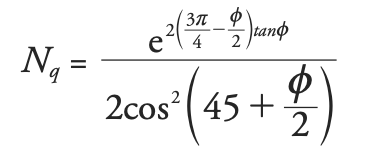

Where Kp γ is the passive earth pressure coefficient = 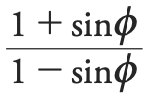
For foundations that exhibit the local shear failure mode in soils, Terzaghi suggested the following modifications to Equation (1):

Nc´, Nq´, and Nγ´ are the modified bearing capacity factors and calculated by replacing ![]() The variation of Nc´, Nq´, and Nγ´ with the soil friction angle ϕ is given in Table 2.
The variation of Nc´, Nq´, and Nγ´ with the soil friction angle ϕ is given in Table 2.
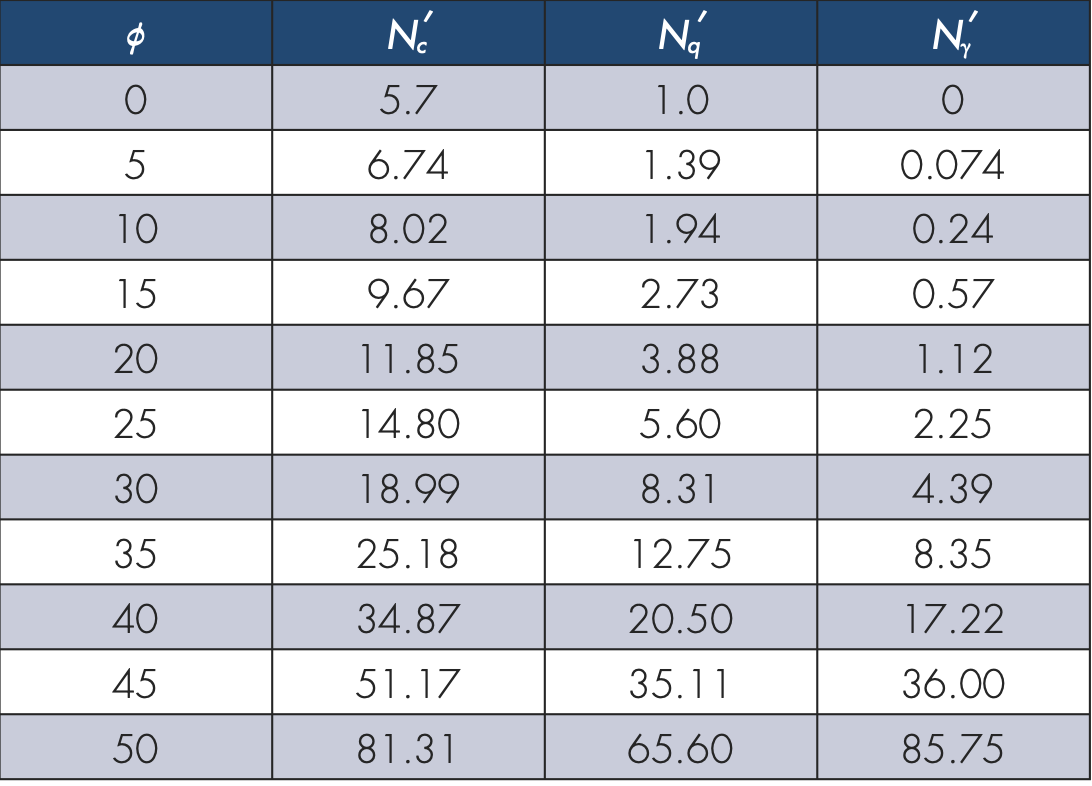
Guidance for selecting general and local shear failure is given in Table 3.

Equations Suggested by Vesic (1975)
Vesic (1975) used the following formulas to compute the bearing capacity factors:

Nc = (Nq − 1)cotϕ or ϕ > 0 (9a)
Nc = 2 + π = 5.14 or ϕ = 0 (9a)
Nγ = 2(Nq + 1)tanϕ (10a)
Vesic (1975) considered the possibility of local shear failure in his bearing capacity equations. Terzaghi (1943), on the other hand, only considered general shear failure. Local shear failure is a type of bearing capacity failure that occurs when the soil beneath the footing is not strong enough to support the load. The soil shears and yields, but the footing does not tilt. This type of failure is common in loose sands and soft clays. General shear failure is a type of bearing capacity failure that occurs when a large portion of the soil beneath the footing shears. This type of failure is common in dense sands and stiff clays. Vesic’s bearing capacity equations are more complex than Terzaghi’s equations because they account for the possibility of local shear failure. Vesic’s equations also include shape factors and depth factors that account for the effects of footing shape and depth on bearing capacity (shape and depth factors are not discussed here).
The German code DIN 4017 uses different values of Nc and Nq than the Terzaghi bearing capacity formula. These values are based on more recent research and were found to be more accurate for German soil conditions. The German code DIN 4017 uses the following expression for Nγ . Note that in this equation (Nq − 1) is used instead of (Nq + 1):
Nγ = (Nq − 1)tanϕ (10b)
It has to be noted that Reissner (1924) was the first to formulate the soil bearing capacity problem, and using some simplifying assumptions, solved it by the methods of theory of plasticity (Vesic, 1975). For weightless soil (γ = 0), he derived the equations for Nq and Nc as given in Equations (8) and 9(a) (Vesic, 1975). It is important to note that both Reissner’s and Terzaghi’s equations for Nq are approximations of the actual bearing capacity of a footing. The most accurate way to determine the bearing capacity of a footing is to perform a load test.
Values of Nγ Suggested by Other Researchers
Brinch Hansen (1970) provided a lower bound expression to experimentally determined values. His expression is of the form:
Nγ = 1.5(Nq − 1)tanϕ (11)
Mayerhof (1963) proposed the following equation:
Nγ = (Nq − 1)tan (1.4ϕ) (12)
Following Terzaghi’s assumptions, Kumbhojkar (1993) developed a numerical solution procedure to determine Nγ and found that the results agreed with Terzaghi’s calculations. The Nγ expressions suggested by different researchers are compared in Table 4. Note that the values of Ncand Nqremain the same for all the researchers.
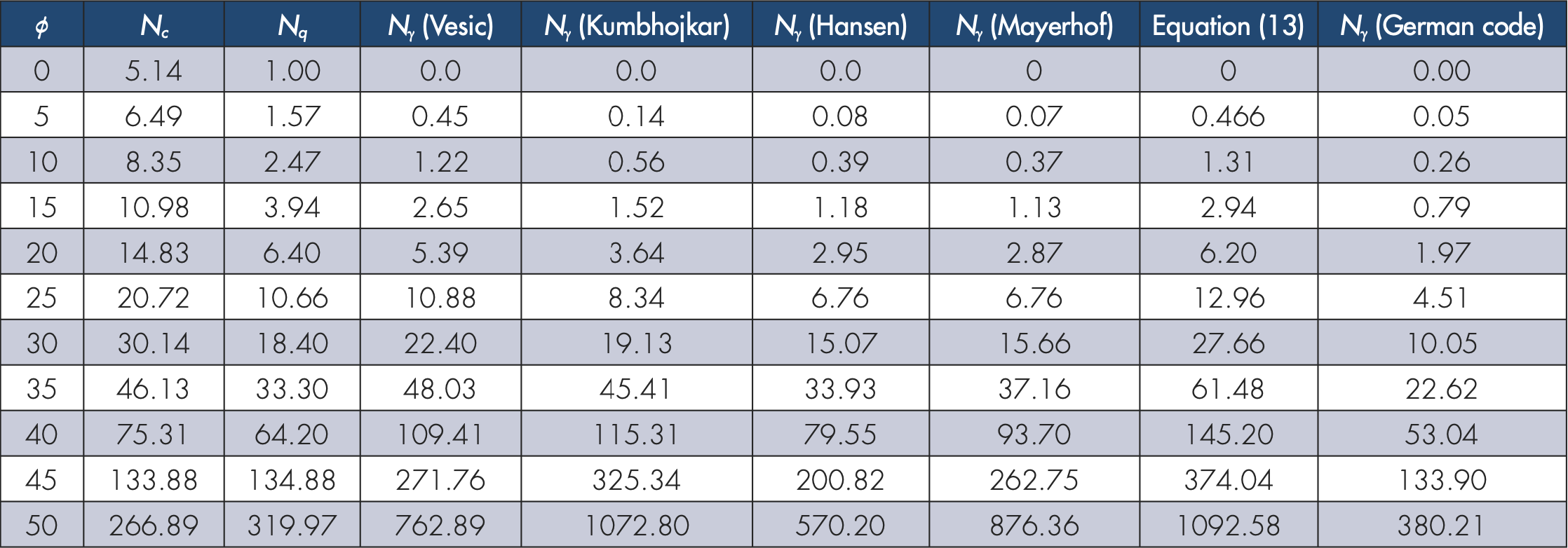
Chen and McCarron (1991) suggested the following equation for Nγ:

The above equation results in a value that is 1.036 times the value of Vesic for ϕ = 5°, 1.235 times the value of Vesic for ϕ = 30°, and 1.376 times the value of Vesic for ϕ = 45°.
Discussions on the Computed Values of Bearing Capacity and the Factor Nγ
The cohesion term (cNc) predominates in cohesive soils, whereas the depth term (γ0 Df Nq) predominates in cohesionless soils; only a small increase in Df will increase qu substantially. The base width term (0.5γ1BNγ) increases bearing capacity for both cohesive and cohesionless soils. According to Coduto (2015), there is much more disagreement regarding using the proper value of Nγ. This is because relatively small changes in the geometry of the failure surface below the footing can create significant differences in Nγ, especially in soils with high friction angles.
It is seen from Table 4, that for angles larger than 35°, the bearing capacity factors change rapidly and by significant amounts. As the estimated bearing capacity qu is further reduced to the allowable safe bearing capacity, qsafe, by using a safety factor, the probability of qsafe being safe is very high. Vesic (1975) recommends that the depth factors (not discussed here) should not be used for shallow foundations (D/B ≤ 1) due to the uncertainties in the quality of overburden. Vesic (1975) commented that the widely used Terzaghi factors shown in Table 1, though not substantially different numerically, are being gradually abandoned, as they are based on obviously incorrect failure patterns. He also mentioned that an increasing trend among practicing engineers and researchers is to use the Nγ values given by Vesic (1975), which are based on the theory by Reissner and later researched by Caquot-Kerisel, and given in Table 4.
Some researchers have found that the value of Nγ is related to the soil friction angle ϕ and other parameters, such as q, c, γ, and B. For example, Xiao et al. (1998) calculated the bearing capacity using the method of characteristics (MOC) and found that Nγ is affected by all q, c, γ, and B and that Nγ is affected by ϕ and γB/(c + qtanϕ) only when the load is vertical. Michalowski (1997) and Silvestri (2003) studied the influence of c/γB and q/γB on Nγ using the limit analysis method and the limit equilibrium method and have shown that for a given value of ϕ, the value of Nγ significantly changes with c/γB or q/γB. Zhu et al. (2003) showed that Nγ is related to the friction angle ϕ and also to the surcharge ratio λ [λ = (q + ccotϕ)/γB].
Han et al. (2016) used a finite difference analysis program. They found that the value of Nγ is influenced not only by the friction angle ϕ but also by the surcharge ratio λ (they note that this conclusion is only valid for Mohr–Coulomb soil). They also studied the relationship of Nγ between smooth and rough foundations (footing-soil interface friction) and found that the value of Nγ for a smooth footing is only about half that for a rough footing. Thus, implying that the roughness of the footing base has a large impact on Nγ. Instead, small values of the interface friction δ (10° to 15°) are required to obtain rough footing effects [Chen and McCarron (1991)]. Table 5 shows the results from their studies for various values of λ for smooth footing, a particular value of λ for rough footing, and also the results obtained by Bolton and Lau (1993), Smith (2005), and Kumar (2009). It is seen that when the surcharge ratio λ = 0, the computed values by them matched the values of other researchers. However, when λ = 104, the computed values were almost double that of λ = 0. The comparisons in Table 5 show that the value of Nγ increases with the increase in λ for a certain friction angle. For smooth and rough footings, when λ = 104, the value of Nγ approaches Chen’s theoretical upper bound value (1975).
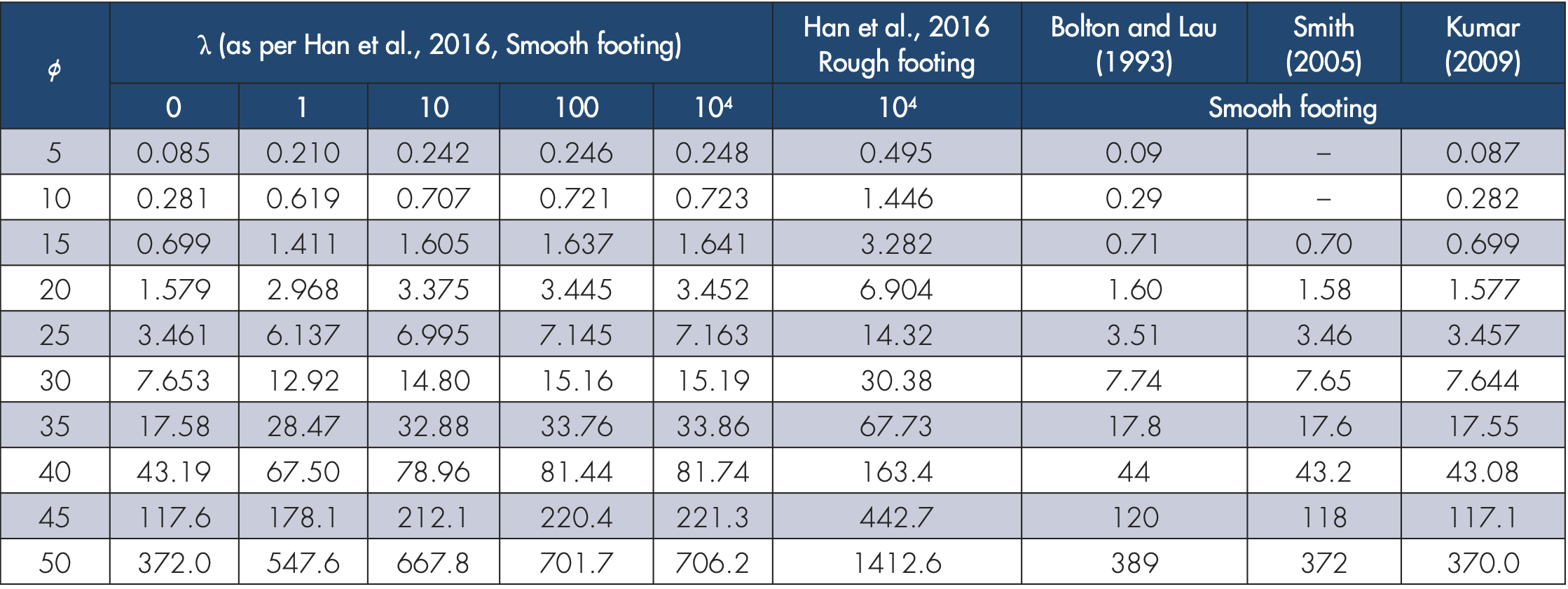
Summary and Conclusions
The safe bearing capacity (SBC) of the soil, qa, at the site is required to design any structure founded on shallow foundations. Although the settlement analysis has to be performed to determine SBC, equations proposed by Terzaghi and later by others to calculate the ultimate bearing capacity have been used and adopted in codes with a safety factor. The equations involve three bearing capacity factors: Nc , Nq, and Nγ . Although the values of Nc and Nq have been accepted by researchers, the value of Nγalone is not accepted and alternate equations have been proposed by many researchers. A few of these alternate equations have been presented and compared. It is seen from Table 4, that for angles larger than 35°, the bearing capacity factors change rapidly and by significant amounts. Hence, one has to be careful while selecting the Nγ value in their calculations. It is seen that the Nγ equation suggested by the German code, DIN 4017, is not only simple in format but also seems to give reasonable values.■
References
Bolton,M.D., and Lau, C.K., (1993) “Vertical bearing capacity factors for circular and strip footings on Mohr-Coulomb soil,” Canadian Geotech Journal, Vol. 30 No.6, pp. 1024–1033
Bowles, J. E., (1996). Foundation Analysis and Design, 5th edition, McGraw-Hill Book Company, New York, 1201 pp.
Chen W.F., (1975) Limit analysis and Soil Plasticity, Elsevier, New York.
Chen, W. F. and McCarron, W. O., (1991) Bearing Capacity of Shallow Foundations, Chapter 4in Foundation Engineering Handbook (ed. H.-Y. Fang), 2nd edition, van Nostrand Reinhold, New York, pp. 144–165
Coduto, D. P., (2015) Foundation design – Principles and practices. 3rd Edition, Prentice Hall 796 p.
Hansen, J. B., (1970) “A Revised and Extended Formula for Bearing Capacity,” Bulletin 28, Danish Geotechnical Institute, Copenhagen.
IS 6403 (1981) Code of Practice for Determination of Bearing Capacity of Shallow Foundations, Bureau of Indian Standards, New Delhi.
Han, D., Xie, X., Zheng, L., and Huang, L., (2016) “The Bearing Capacity Factor Nγ of Strip Footings on c-φ-γ Soil Using the Method of Characteristics,” Springer Plus, Vol.5, 1482.
Kumar, J., (2009) “The variation of Nγ with footing roughness using the method of characteristics,” International Journal for Numerical & Analytical Methods in Geomech, Vol. 33, No.21, pp. 275–284
Kumbhojkar, A. S., (1993) “Numerical Evaluation of Terzaghi’s Nγ”, Journal of Geotechnical Engineering, American Society of Civil Engineers, Vol. 119, No. 3, pp. 598–607.
Meyerhof, G. G., (1963). “Some Recent Research on the Bearing Capacity of Foundations,” Canadian Geotechnical Journal, Vol. 1, No. 1, pp. 16–26.
Michalowski R.L, (1997) “An estimate of the influence of soil weight on bearing capacity using limit analysis,” Soils and Foundations, Vol. 37 No. 4, pp. 57–64.
Reissner, H., (1924) “Zum Erddruckproblem,” Proceedings, First International Congress of Applied Mechanics, Delft, pp. 295–311.
Silvestri V., (2003) “A limit equilibrium solution for bearing capacity of strip foundations on sand,” Canadian Geotech Journal, Vol.40, No. 2, pp. 351–361.
Smith, C.C., (2005) “Complete limiting stress solutions for the bearing capacity of strip footings on a Mohr-Coulomb soil,” Geotechnique, Vol. 55, No.8, pp. 607–612
Terzaghi, K., (1943) Theoretical Soil Mechanics, John Wiley and Sons, New York, 510 pp.
Vesic, A. S., (1975) Bearing Capacity of Shallow Foundations. Chapter 3 in Foundation Engineering Handbook, edited by H. F. Winterkorn and H-Y Fang, VanNostrand Reinhold Company, pp. 121–147.
Xiao, D.P., Zhu, W.Y., and Chen, H., (1998) “Progress in slip lines method to solve the bearing capacity,” Chinese Journal of Geotech Engg., Vol. 20, No. 4, pp. 25–29 (In Chinese)
Zhu, D.Y., Lee C.F., and Law K.T., (2003) “Determination of bearing capacity of shallow foundations without using superposition approximation,” Canadian Geotech. Journal, Vol. 40, No.2, pp. 450–459
